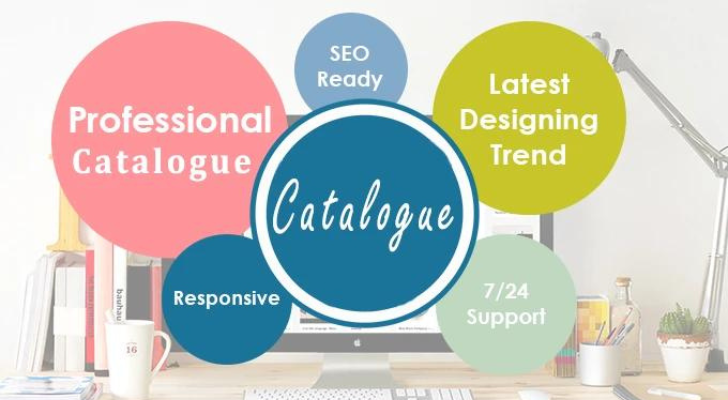Catalog Website

A catalog website serves as a digital showcase, offering users a visually appealing and organized platform to explore products, services, or information. Whether you're presenting a collection of products, showcasing artworks, or highlighting educational materials, creating an effective catalog website involves thoughtful design and user-friendly features. Let's delve into key elements and considerations for crafting a compelling catalog website.
1. Clean and Intuitive Design: Start with a clean and intuitive design that focuses on highlighting the content. Use a visually appealing layout with organized sections, ensuring that users can easily navigate and find what they're looking for.
2. Categorized Content: Organize content into relevant categories and subcategories. A well-structured hierarchy simplifies the user journey and helps visitors quickly locate specific items or information within the catalog.
3. High-Quality Visuals: Visual appeal is paramount in a catalog website. Use high-quality images or multimedia elements to showcase products or content. Ensure consistency in image sizes and resolutions for a polished and professional look.
4. Detailed Product Descriptions: Provide detailed and informative descriptions for each item in the catalog. Include specifications, features, pricing information, and any other relevant details. Clear and compelling product descriptions contribute to informed decision-making.
5. Search Functionality: Implement a robust search functionality that allows users to find specific items quickly. Include filters, sorting options, and a search bar to enhance user experience, especially when dealing with large catalogs.
6. Responsive Design: Optimize your catalog website for various devices, ensuring a seamless experience on desktops, tablets, and smartphones. A responsive design enhances accessibility and caters to users with different browsing habits.
7. Quick View and Product Details: Incorporate a "quick view" feature that allows users to preview product details without navigating away from the catalog page. Include a link to the full product page for those who want more information.
8. User-Friendly Navigation: Enable easy navigation with clear menus and intuitive paths. Visitors should be able to explore different sections of the catalog effortlessly. Consider a breadcrumb navigation trail to help users understand their location within the catalog.
9. Dynamic Content Updates: Keep the catalog content dynamic and up-to-date. Regularly update product listings, add new items, and remove outdated information. This ensures that visitors encounter fresh content each time they explore the catalog.
10. Call-to-Action (CTA) Buttons: Strategically place CTA buttons, encouraging users to take specific actions, such as making a purchase, requesting more information, or downloading resources. Well-designed CTAs guide users toward meaningful interactions.
11. Interactive Features: Enhance engagement with interactive features. Consider incorporating features like sliders, zoom-in capabilities for images, and 360-degree views for products. Interactive elements contribute to a more immersive browsing experience.
12. Analytics Integration: Integrate analytics tools to gather insights into user behavior. Understand which products are popular, track user interactions, and identify areas for improvement. Analytics data helps in refining the catalog and enhancing the overall user experience.
Example Catalog Website Feature:
Product Comparison Tool: Allow users to compare multiple products side by side, highlighting key features, specifications, and pricing. This tool assists users in making informed decisions.
🚀 Master Top Web & App Frameworks
Explore structured tutorials for AngularJS, React, Laravel, Flutter, PHP, SQL, and more.
📘 Introduction to AngularJS
Introduction to AngularJS overview
📘 Introduction to Laravel
Learn Introduction to Laravel in Laravel with real-world examples and step-by-step guide.
📘 Introduction to CodeIgniter
An introduction to Introduction to CodeIgniter in CodeIgniter with examples.
📘 Introduction to React
Quick overview and guide to Introduction to React in React JS.
📘 Introduction to Flutter
An easy-to-follow tutorial on Introduction to Flutter in Flutter mobile app development.
📘 Introduction to Kotlin
Learn Introduction to Kotlin in Kotlin programming with examples for Android or backend apps.
📘 Introduction to PHP
Understand Introduction to PHP in PHP with practical examples and clear syntax.
📘 Introduction to SQL
Understand Introduction to SQL in SQL for effective database querying and management.
📘 Introduction to Bootstrap 5
Understand Introduction to Bootstrap 5 in Bootstrap 5 for responsive web design using pre-built components.
📘 Introduction to HTML
Understand Introduction to HTML in HTML to create structured, semantic, and accessible web content.
📘 Introduction to CSS
Explore Introduction to CSS in CSS to enhance web design using styling properties and layout techniques.
📘 Introduction to JavaScript
Understand Introduction to JavaScript in JavaScript to build dynamic and interactive web experiences.
📘 Introduction to Node.js
Explore Introduction to Node.js in NodeJS for backend development using JavaScript and non-blocking architecture.
📘 Introduction to AJAX
Understand Introduction to AJAX in AJAX to update web pages without full reloads using asynchronous JavaScript and XML.
📘 Introduction to jQuery
Learn Introduction to jQuery in jQuery to write less and do more with simplified JavaScript operations and cross-brow...
📰 Latest Blog Posts
Insights, tutorials, and tech stories from our experts.
Transform Your Passion into a Web Development Career
Do you love tech? Let’s turn it into a profession with full stack development.
Not Just Coding – Career-Focused Full Stack Training
We don’t just teach code—we teach how to get jobs with it.
Learn, Code, Build, Get Hired – Full Stack Program
A step-by-step path to go from beginner to hired developer.
BCA/MCA/B.Tech? Start Building Real Websites Now!
Already pursuing IT education? Now build real websites with us!
Offline Full Stack Training in Dwarka & Uttam Nagar – Limited Seats!
Join our offline batch in Dwarka or Uttam Nagar and learn full stack development practically.
Struggling in Interviews? Build Skills That Get You Hired!
Facing rejections in job interviews? Build the right skills and project experience.


